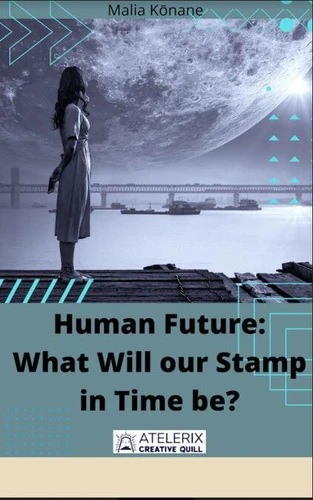Human Future: What Will our Stamp in Time be?
Par :Formats :
Disponible dans votre compte client Decitre ou Furet du Nord dès validation de votre commande. Le format ePub est :
- Compatible avec une lecture sur My Vivlio (smartphone, tablette, ordinateur)
- Compatible avec une lecture sur liseuses Vivlio
- Pour les liseuses autres que Vivlio, vous devez utiliser le logiciel Adobe Digital Edition. Non compatible avec la lecture sur les liseuses Kindle, Remarkable et Sony
 , qui est-ce ?
, qui est-ce ?Notre partenaire de plateforme de lecture numérique où vous retrouverez l'ensemble de vos ebooks gratuitement
Pour en savoir plus sur nos ebooks, consultez notre aide en ligne ici
- FormatePub
- ISBN8201908683
- EAN9798201908683
- Date de parution30/04/2022
- Protection num.pas de protection
- Infos supplémentairesepub
- ÉditeurJL
Résumé
In 1924, the skull of a 3-year-old boy found in South Africa forever changed the way people thought about human origins. The so-called Taung Child, our first encounter with an ancient group of protohumans called Australopithecines, was a turning point in the study of our evolution. This discovery shifted the focus of studying human origins from Europe and Asia to Africa and set the stage for the last century of research on the continent and in its "cradles of humanity." Few would have predicted then what scientists know today about our evolution.
The pace of discoveries is faster than ever. Even so far in the 21st century, textbooks on human origins have been rewritten several times. Just 20 years ago, no one would have imagined what scientists know two decades later about humanity's remote past. Much less how much knowledge a ground thimble, a dental plaque trail, and even orbiting satellites can offer. Human fossils exceed Darwin's tree.
In Africa there are several candidate fossils to be the first hominin, between 5 and 7 million years ago. That's when humans split from other great apes, something we know from differences in our DNA. Although it was discovered in the 1990s, the publication of the 4.4 million-year-old skeleton nicknamed "Ardi" in 2009 changed scientists' opinion on how hominids began to walk. Rounding out our new relatives are some australopithecines, such as Australopithecus deyiremeda and Australopithecus sediba, as well as a very primitive species of Homo that survived until late in our evolutionary history and that rekindled the debate about when humans began to bury their dead. When you are done reading this book, you will have gained a lifetime of experience in just a few short hours.
The stories are interesting to follow, and the challenging concepts have been made easy to understand. So get ready to broaden your horizons and adjust your expectations because you are in for one hell of a ride!Are you ready?If you are, Click Buy Now With 1-Click or Buy Now to get started!
The pace of discoveries is faster than ever. Even so far in the 21st century, textbooks on human origins have been rewritten several times. Just 20 years ago, no one would have imagined what scientists know two decades later about humanity's remote past. Much less how much knowledge a ground thimble, a dental plaque trail, and even orbiting satellites can offer. Human fossils exceed Darwin's tree.
In Africa there are several candidate fossils to be the first hominin, between 5 and 7 million years ago. That's when humans split from other great apes, something we know from differences in our DNA. Although it was discovered in the 1990s, the publication of the 4.4 million-year-old skeleton nicknamed "Ardi" in 2009 changed scientists' opinion on how hominids began to walk. Rounding out our new relatives are some australopithecines, such as Australopithecus deyiremeda and Australopithecus sediba, as well as a very primitive species of Homo that survived until late in our evolutionary history and that rekindled the debate about when humans began to bury their dead. When you are done reading this book, you will have gained a lifetime of experience in just a few short hours.
The stories are interesting to follow, and the challenging concepts have been made easy to understand. So get ready to broaden your horizons and adjust your expectations because you are in for one hell of a ride!Are you ready?If you are, Click Buy Now With 1-Click or Buy Now to get started!
In 1924, the skull of a 3-year-old boy found in South Africa forever changed the way people thought about human origins. The so-called Taung Child, our first encounter with an ancient group of protohumans called Australopithecines, was a turning point in the study of our evolution. This discovery shifted the focus of studying human origins from Europe and Asia to Africa and set the stage for the last century of research on the continent and in its "cradles of humanity." Few would have predicted then what scientists know today about our evolution.
The pace of discoveries is faster than ever. Even so far in the 21st century, textbooks on human origins have been rewritten several times. Just 20 years ago, no one would have imagined what scientists know two decades later about humanity's remote past. Much less how much knowledge a ground thimble, a dental plaque trail, and even orbiting satellites can offer. Human fossils exceed Darwin's tree.
In Africa there are several candidate fossils to be the first hominin, between 5 and 7 million years ago. That's when humans split from other great apes, something we know from differences in our DNA. Although it was discovered in the 1990s, the publication of the 4.4 million-year-old skeleton nicknamed "Ardi" in 2009 changed scientists' opinion on how hominids began to walk. Rounding out our new relatives are some australopithecines, such as Australopithecus deyiremeda and Australopithecus sediba, as well as a very primitive species of Homo that survived until late in our evolutionary history and that rekindled the debate about when humans began to bury their dead. When you are done reading this book, you will have gained a lifetime of experience in just a few short hours.
The stories are interesting to follow, and the challenging concepts have been made easy to understand. So get ready to broaden your horizons and adjust your expectations because you are in for one hell of a ride!Are you ready?If you are, Click Buy Now With 1-Click or Buy Now to get started!
The pace of discoveries is faster than ever. Even so far in the 21st century, textbooks on human origins have been rewritten several times. Just 20 years ago, no one would have imagined what scientists know two decades later about humanity's remote past. Much less how much knowledge a ground thimble, a dental plaque trail, and even orbiting satellites can offer. Human fossils exceed Darwin's tree.
In Africa there are several candidate fossils to be the first hominin, between 5 and 7 million years ago. That's when humans split from other great apes, something we know from differences in our DNA. Although it was discovered in the 1990s, the publication of the 4.4 million-year-old skeleton nicknamed "Ardi" in 2009 changed scientists' opinion on how hominids began to walk. Rounding out our new relatives are some australopithecines, such as Australopithecus deyiremeda and Australopithecus sediba, as well as a very primitive species of Homo that survived until late in our evolutionary history and that rekindled the debate about when humans began to bury their dead. When you are done reading this book, you will have gained a lifetime of experience in just a few short hours.
The stories are interesting to follow, and the challenging concepts have been made easy to understand. So get ready to broaden your horizons and adjust your expectations because you are in for one hell of a ride!Are you ready?If you are, Click Buy Now With 1-Click or Buy Now to get started!






















